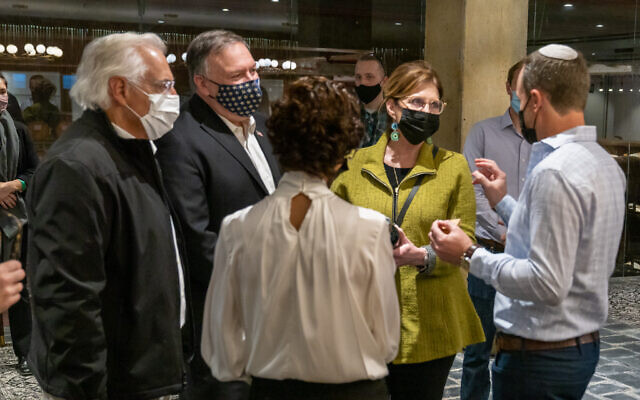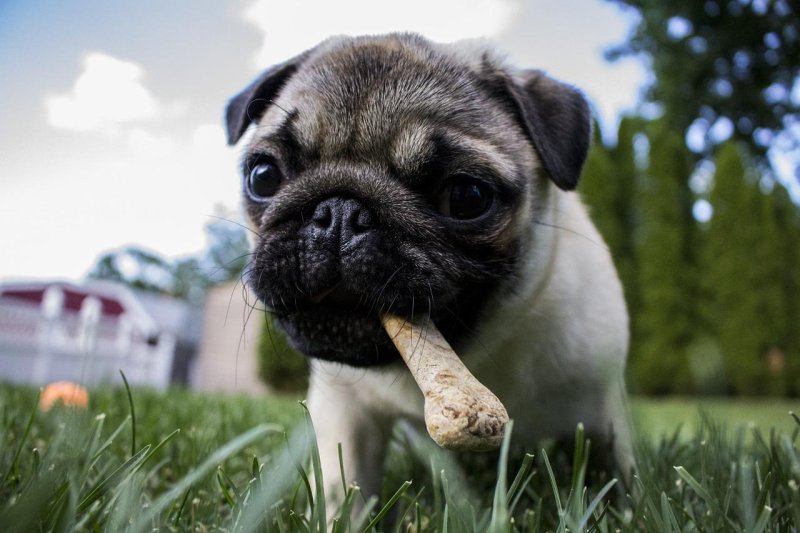CTHULHU STUDIES
A lab in Massachusetts may have finally found an eight-armed cephalopod that can serve as a model organism and assist scientific research
PUBLISHED : 17 APR 2022
NEWSPAPER SECTION: SUNDAY SPOTLIGHT
WRITER: ELIZABETH PRESTON

Bret Grasse, a manager of cephalopod operations at the Marine Biological Laboratory, and a lesser Pacific striped octopus, in Woods Hole, Massachusetts.
MATT COSBY/nyt
LONG READ
The tank looked empty, but turning over a shell revealed a hidden octopus no bigger than a Ping-Pong ball. She didn't move. Then all at once, she stretched her ruffled arms as her skin changed from pearly beige to a pattern of vivid bronze stripes.
"She's trying to talk with us," said Bret Grasse, manager of cephalopod operations at the Marine Biological Laboratory (MBL), an international research centre in Woods Hole, Massachusetts, in the southwestern corner of Cape Cod.

A wild 'chierchiae', a miniature, zebra-striped octopus, at the lab.
LONG READ
The tank looked empty, but turning over a shell revealed a hidden octopus no bigger than a Ping-Pong ball. She didn't move. Then all at once, she stretched her ruffled arms as her skin changed from pearly beige to a pattern of vivid bronze stripes.
"She's trying to talk with us," said Bret Grasse, manager of cephalopod operations at the Marine Biological Laboratory (MBL), an international research centre in Woods Hole, Massachusetts, in the southwestern corner of Cape Cod.

A wild 'chierchiae', a miniature, zebra-striped octopus, at the lab.
MATT COSBY/nyt
The tiny, striped octopus is part of an experimental colony at the lab where scientists are trying to turn cephalopods into model organisms: animals that can live and reproduce in research institutions and contribute to scientific study over many generations, like mice or fruit flies do.
Cephalopods fascinate scientists for many reasons, including their advanced, camera-like eyes and large brains, which evolved independently from the eyes and brains of humans and our backboned relatives.

Joshua Rosenthal, a neurobiologist, at the Marine Biological Laboratory in Woods Hole. MATT COSBY/nyt
An octopus, cuttlefish or squid is essentially a snail that swapped its shell for smarts. "They have the biggest brain of any invertebrate by far," said Joshua Rosenthal, a neurobiologist at the Marine Biological Laboratory. "I mean, it's not even close."
Model cephalopods would be a boon for biologists. But keeping these brainy and often bizarre animals in captivity -- particularly octopuses -- presents both ethical and logistical challenges.
The researchers at Woods Hole have had earlier success with raising squid over multiple generations. Yet a single squid can't tell scientists everything about cephalopods.

Caroline Albertin, a developmental biologist at the lab. MATT COSBY/nyt
"Having different models to answer different questions is, I think, incredibly valuable," said Caroline Albertin, a developmental biologist at the facility.
But octopuses have long confounded scientists because of several unfortunate habits: They eat each other. They're notorious escape artists. Mothers die as soon as they reproduce, so it's hard to build up a breeding population.
That has made the model octopus a kind of white whale -- until last year, when Mr Grasse and his colleagues announced they had raised three consecutive generations of an especially promising octopus species in their lab, more than anyone had before.
Meet Octopus chierchiae, a miniature, zebra-striped octopus with a trick up its sleeves.
Roy Caldwell, a behavioural ecologist at the University of California, Berkeley, first met Octopus chierchiae, also called the lesser Pacific striped octopus, in the mid-1970s in Panama.
He was pulling rocks from the ocean to find mantis shrimp hiding in cracks. "Every once in a while, these cute little striped octopus would come out," he said.
He brought a few of the octopuses back to Berkeley. Soon after, "One of the females laid eggs, and I thought that was kind of a bummer because I knew that she would die," Prof Caldwell said. "And she didn't die." A couple of months later, she laid eggs again.
A 1984 paper by Arcadio Rodaniche, a Panamanian scientist, confirmed Prof Caldwell's observation: Females of this species, unlike nearly every other octopus, could reproduce several times.

A soda bottle adapted for use as an incubator for baby cephalopods at the lab. MATT COSBY/nyt
This trait, combined with their convenient size, made them an enticing subject for lab research. Unfortunately, Prof Caldwell couldn't find any more in Panama. None of the biologists or collectors he asked had seen any, either.
The little cephalopod was only a memory until around 2010, when "I got an email from a high school student," Prof Caldwell said, "who wanted to know how he could take care of his new pet octopus". The student sent a photo. The octopus's zebra stripes were unmistakable.
Prof Caldwell traced the octopus back to a collector in Nicaragua. Finally, he could obtain a few lesser Pacific striped octopuses and try to get a colony going in his lab.
But over three or four years of attempts, he never got past the second generation. After that, Prof Caldwell said, the females' eggs didn't hatch. He suspected inbreeding was a problem, as well as diet. "We didn't know quite what to feed them."
That question was still unanswered in 2016, when Mr Rosenthal came to the Marine Biological Laboratory with a dream of making model cephalopods to aid scientific research.

Bret Grasse, a manager of cephalopod operations at the lab, checks on some of his charges. MATT COSBY/nyt
He recruited Mr Grasse, who was known as something of a cephalopod whisperer, from the Monterey Bay Aquarium in California. Taylor Sakmar, also a Monterey Bay aquarist, came to Cape Cod to help build a new kind of facility for many-armed animals.
Today, that facility is a dim, burbling room packed with rows of tanks and smelling of seawater. People squeeze between racks, checking tanks, mopping puddles and feeding several species of cephalopod around the clock.
When the scientists started their Octopus chierchiae colony in 2018 with seven animals from Nicaragua, they offered the creatures a buffet of live and frozen seafood.
Then they watched the animals' body language and changing skin colours to see what they liked best. (Lesser Pacific striped octopuses always have their stripes, but can dial up the contrast or fade the stripes away almost entirely.)
"After you work with these cephalopods long enough, you essentially can learn how to speak cephalopod," Mr Grasse said.
An octopus will reach out to taste an offered item with its suckers. If it tastes good, the octopus quickly wraps the food close with all eight arms and scoots off to a shelter to eat it. If it doesn't like what's offered, the octopus may fling the food onto the side of its tank.
Observing the octopuses in their care, the scientists also discovered that males who are ready to mate perform a rapidly vibrating dance with their arm tips, as if twirling a bunch of maracas.
The tiny, striped octopus is part of an experimental colony at the lab where scientists are trying to turn cephalopods into model organisms: animals that can live and reproduce in research institutions and contribute to scientific study over many generations, like mice or fruit flies do.
Cephalopods fascinate scientists for many reasons, including their advanced, camera-like eyes and large brains, which evolved independently from the eyes and brains of humans and our backboned relatives.

Joshua Rosenthal, a neurobiologist, at the Marine Biological Laboratory in Woods Hole. MATT COSBY/nyt
An octopus, cuttlefish or squid is essentially a snail that swapped its shell for smarts. "They have the biggest brain of any invertebrate by far," said Joshua Rosenthal, a neurobiologist at the Marine Biological Laboratory. "I mean, it's not even close."
Model cephalopods would be a boon for biologists. But keeping these brainy and often bizarre animals in captivity -- particularly octopuses -- presents both ethical and logistical challenges.
The researchers at Woods Hole have had earlier success with raising squid over multiple generations. Yet a single squid can't tell scientists everything about cephalopods.

Caroline Albertin, a developmental biologist at the lab. MATT COSBY/nyt
"Having different models to answer different questions is, I think, incredibly valuable," said Caroline Albertin, a developmental biologist at the facility.
But octopuses have long confounded scientists because of several unfortunate habits: They eat each other. They're notorious escape artists. Mothers die as soon as they reproduce, so it's hard to build up a breeding population.
That has made the model octopus a kind of white whale -- until last year, when Mr Grasse and his colleagues announced they had raised three consecutive generations of an especially promising octopus species in their lab, more than anyone had before.
Meet Octopus chierchiae, a miniature, zebra-striped octopus with a trick up its sleeves.
Roy Caldwell, a behavioural ecologist at the University of California, Berkeley, first met Octopus chierchiae, also called the lesser Pacific striped octopus, in the mid-1970s in Panama.
He was pulling rocks from the ocean to find mantis shrimp hiding in cracks. "Every once in a while, these cute little striped octopus would come out," he said.
He brought a few of the octopuses back to Berkeley. Soon after, "One of the females laid eggs, and I thought that was kind of a bummer because I knew that she would die," Prof Caldwell said. "And she didn't die." A couple of months later, she laid eggs again.
A 1984 paper by Arcadio Rodaniche, a Panamanian scientist, confirmed Prof Caldwell's observation: Females of this species, unlike nearly every other octopus, could reproduce several times.

A soda bottle adapted for use as an incubator for baby cephalopods at the lab. MATT COSBY/nyt
This trait, combined with their convenient size, made them an enticing subject for lab research. Unfortunately, Prof Caldwell couldn't find any more in Panama. None of the biologists or collectors he asked had seen any, either.
The little cephalopod was only a memory until around 2010, when "I got an email from a high school student," Prof Caldwell said, "who wanted to know how he could take care of his new pet octopus". The student sent a photo. The octopus's zebra stripes were unmistakable.
Prof Caldwell traced the octopus back to a collector in Nicaragua. Finally, he could obtain a few lesser Pacific striped octopuses and try to get a colony going in his lab.
But over three or four years of attempts, he never got past the second generation. After that, Prof Caldwell said, the females' eggs didn't hatch. He suspected inbreeding was a problem, as well as diet. "We didn't know quite what to feed them."
That question was still unanswered in 2016, when Mr Rosenthal came to the Marine Biological Laboratory with a dream of making model cephalopods to aid scientific research.

Bret Grasse, a manager of cephalopod operations at the lab, checks on some of his charges. MATT COSBY/nyt
He recruited Mr Grasse, who was known as something of a cephalopod whisperer, from the Monterey Bay Aquarium in California. Taylor Sakmar, also a Monterey Bay aquarist, came to Cape Cod to help build a new kind of facility for many-armed animals.
Today, that facility is a dim, burbling room packed with rows of tanks and smelling of seawater. People squeeze between racks, checking tanks, mopping puddles and feeding several species of cephalopod around the clock.
When the scientists started their Octopus chierchiae colony in 2018 with seven animals from Nicaragua, they offered the creatures a buffet of live and frozen seafood.
Then they watched the animals' body language and changing skin colours to see what they liked best. (Lesser Pacific striped octopuses always have their stripes, but can dial up the contrast or fade the stripes away almost entirely.)
"After you work with these cephalopods long enough, you essentially can learn how to speak cephalopod," Mr Grasse said.
An octopus will reach out to taste an offered item with its suckers. If it tastes good, the octopus quickly wraps the food close with all eight arms and scoots off to a shelter to eat it. If it doesn't like what's offered, the octopus may fling the food onto the side of its tank.
Observing the octopuses in their care, the scientists also discovered that males who are ready to mate perform a rapidly vibrating dance with their arm tips, as if twirling a bunch of maracas.
MATT COSBY/nyt
After the octopuses mated and babies emerged from their eggs, Mr Grasse housed the young -- which are bright orange and smaller than a lentil -- in individual PVC-pipe cylinders so they wouldn't snack on one another. He discovered that the hatchlings go through a phase of "intense swimming", where they can escape through the tiniest gap between an enclosure and its lid.
Typically, materials such as AstroTurf or the fuzzy side of a Velcro strip can keep octopuses from scaling vertical surfaces, Mr Grasse said, because their suckers won't stick. But the extra-small babies of the lesser Pacific striped octopuses could climb these materials like a ladder.
"Typically, octopuses are more easily secured than this species," Mr Grasse said.
He now uses expandable foam lids to tightly seal the hatchlings' enclosures. A tank for adult Octopus chierchiae has a perimeter of Velcro, along with what Mr Grasse called his "really high-tech security system" -- a heavy rock on the lid.
In 2015, Ms Albertin was part of a team that sequenced the very first cephalopod genome. "I am astonished at how fast this has all gone," she said. "Cephalopods have a lot to teach us about the world. And we're finally at a point where we can try to start understanding them."
But an ideal lab animal for the molecular age isn't just one you can keep healthy for many generations, Mr Rosenthal said. It's also one whose DNA scientists can manipulate.
By turning genes off, or adding new genes or markers to an animal's cells, scientists can see the machinery of biology more clearly. Such research in mice and other lab animals has let researchers directly test the roles of individual genes, for example, and create animal models of human diseases. But it has been more challenging with cephalopods, especially the octopus.
Researchers at the Marine Biological Laboratory have succeeded in using the tool CRISPR-Cas9 to edit the genes of a squid local to Cape Cod, as well as the lab's hummingbird bobtail squid, they said.
To inject materials into these animals' tough eggs, they've used sharpened quartz needles and specially designed tiny scissors.
For scientists who want to manipulate cephalopod genetics, the hummingbird bobtail squid is the most promising model animal to date, Ms Albertin said: "Easy to raise, easy to poke and easy to keep in our incubation chambers."
But studying squid isn't enough.
"People often think about cephalopods as kind of all the same thing," Ms Albertin said. "Octopuses, squid -- they're all squishy and float around in the ocean. But they're actually quite different."
There's a problem with octopus eggs. All the ones Ms Albertin has worked with have a "hard, leathery eggshell", she said. Her needles can't pierce it.
She's been able to cut into the eggs with scissors -- only to encounter another problem, which Mr Rosenthal politely called "positive pressure", and Ms Albertin described as the yolk "squeezing out of its eggshell like toothpaste out of a tube".
"Honestly, I don't know that anyone has figured out how to inject into an octopus egg yet," Ms Albertin said.
The scientists don't think it's impossible. But they'll have to figure it out before the lesser Pacific striped octopus becomes the type of model organism Mr Rosenthal has envisioned.
While gene editing with the lesser Pacific striped octopus remains elusive, the species could help tackle another cephalopod mystery.
Octopus bimaculoides, or the California two-spot octopus, is a common lab cephalopod that scientists can get from the wild. But it has disadvantages. For one, it's much bigger -- a two-spot octopus tank at the Marine Biological Laboratory has a brick on top so its occupant can't get out.
The other problem is that the mums die. One two-spot octopus at the lab was active and curious, shooting a jet of water at visitors; a neighbouring tank held a dying female hunched over her clusters of transparent eggs. The mother was unmoving, one eye visible.
The rapid decline of mother octopuses fascinates Z Yan Wang, an evolutionary neuroscientist at the University of Washington, Seattle. "This animal that has such a complex nervous system lives such a short amount of time," Prof Wang said.
In a 2018 study, she documented how female two-spot octopuses first stopped eating while they tended their eggs, stroking them and blowing water across them. Then the mothers turned pale and began acting strangely, sometimes eating their own arm tips or wounding themselves with their suckers, before dying.
Prof Wang hopes to learn more about this process when she launches her own lab this autumn. She plans to acquire lesser Pacific striped octopuses from the colony started by Mr Grasse and company, and start her own colony using their methods. In the animals' brains, she may find the key that lets them survive reproduction.
She has been meeting with a group of other cephalopod researchers, including the Cape Cod team, to talk about how to move forward with using the lesser Pacific striped octopus in research. "We're all very invested in this species," Prof Wang said.
Prof Caldwell, who wasn't able to breed Octopus chierchiae beyond two generations, has also been a part of these conversations. He said the results at the facility in Woods Hole, keeping the animals alive for three generations, show promise.
From the seven wild Octopus chierchiae, Mr Grasse and his colleagues have raised over 700 children, grandchildren and great-grandchildren. In the last generation, though, they let the colony peter out.
It was 2020, and because of Covid restrictions, only one person could be in the facility at a time.

A two-spot octopus, with a brick atop his aquarium lid to thwart his ability to escape, at the lab.
After the octopuses mated and babies emerged from their eggs, Mr Grasse housed the young -- which are bright orange and smaller than a lentil -- in individual PVC-pipe cylinders so they wouldn't snack on one another. He discovered that the hatchlings go through a phase of "intense swimming", where they can escape through the tiniest gap between an enclosure and its lid.
Typically, materials such as AstroTurf or the fuzzy side of a Velcro strip can keep octopuses from scaling vertical surfaces, Mr Grasse said, because their suckers won't stick. But the extra-small babies of the lesser Pacific striped octopuses could climb these materials like a ladder.
"Typically, octopuses are more easily secured than this species," Mr Grasse said.
He now uses expandable foam lids to tightly seal the hatchlings' enclosures. A tank for adult Octopus chierchiae has a perimeter of Velcro, along with what Mr Grasse called his "really high-tech security system" -- a heavy rock on the lid.
In 2015, Ms Albertin was part of a team that sequenced the very first cephalopod genome. "I am astonished at how fast this has all gone," she said. "Cephalopods have a lot to teach us about the world. And we're finally at a point where we can try to start understanding them."
But an ideal lab animal for the molecular age isn't just one you can keep healthy for many generations, Mr Rosenthal said. It's also one whose DNA scientists can manipulate.
By turning genes off, or adding new genes or markers to an animal's cells, scientists can see the machinery of biology more clearly. Such research in mice and other lab animals has let researchers directly test the roles of individual genes, for example, and create animal models of human diseases. But it has been more challenging with cephalopods, especially the octopus.
Researchers at the Marine Biological Laboratory have succeeded in using the tool CRISPR-Cas9 to edit the genes of a squid local to Cape Cod, as well as the lab's hummingbird bobtail squid, they said.
To inject materials into these animals' tough eggs, they've used sharpened quartz needles and specially designed tiny scissors.
For scientists who want to manipulate cephalopod genetics, the hummingbird bobtail squid is the most promising model animal to date, Ms Albertin said: "Easy to raise, easy to poke and easy to keep in our incubation chambers."
But studying squid isn't enough.
"People often think about cephalopods as kind of all the same thing," Ms Albertin said. "Octopuses, squid -- they're all squishy and float around in the ocean. But they're actually quite different."
There's a problem with octopus eggs. All the ones Ms Albertin has worked with have a "hard, leathery eggshell", she said. Her needles can't pierce it.
She's been able to cut into the eggs with scissors -- only to encounter another problem, which Mr Rosenthal politely called "positive pressure", and Ms Albertin described as the yolk "squeezing out of its eggshell like toothpaste out of a tube".
"Honestly, I don't know that anyone has figured out how to inject into an octopus egg yet," Ms Albertin said.
The scientists don't think it's impossible. But they'll have to figure it out before the lesser Pacific striped octopus becomes the type of model organism Mr Rosenthal has envisioned.
While gene editing with the lesser Pacific striped octopus remains elusive, the species could help tackle another cephalopod mystery.
Octopus bimaculoides, or the California two-spot octopus, is a common lab cephalopod that scientists can get from the wild. But it has disadvantages. For one, it's much bigger -- a two-spot octopus tank at the Marine Biological Laboratory has a brick on top so its occupant can't get out.
The other problem is that the mums die. One two-spot octopus at the lab was active and curious, shooting a jet of water at visitors; a neighbouring tank held a dying female hunched over her clusters of transparent eggs. The mother was unmoving, one eye visible.
The rapid decline of mother octopuses fascinates Z Yan Wang, an evolutionary neuroscientist at the University of Washington, Seattle. "This animal that has such a complex nervous system lives such a short amount of time," Prof Wang said.
In a 2018 study, she documented how female two-spot octopuses first stopped eating while they tended their eggs, stroking them and blowing water across them. Then the mothers turned pale and began acting strangely, sometimes eating their own arm tips or wounding themselves with their suckers, before dying.
Prof Wang hopes to learn more about this process when she launches her own lab this autumn. She plans to acquire lesser Pacific striped octopuses from the colony started by Mr Grasse and company, and start her own colony using their methods. In the animals' brains, she may find the key that lets them survive reproduction.
She has been meeting with a group of other cephalopod researchers, including the Cape Cod team, to talk about how to move forward with using the lesser Pacific striped octopus in research. "We're all very invested in this species," Prof Wang said.
Prof Caldwell, who wasn't able to breed Octopus chierchiae beyond two generations, has also been a part of these conversations. He said the results at the facility in Woods Hole, keeping the animals alive for three generations, show promise.
From the seven wild Octopus chierchiae, Mr Grasse and his colleagues have raised over 700 children, grandchildren and great-grandchildren. In the last generation, though, they let the colony peter out.
It was 2020, and because of Covid restrictions, only one person could be in the facility at a time.

A two-spot octopus, with a brick atop his aquarium lid to thwart his ability to escape, at the lab.
MATT COSBY/nyt
The scientists had to put the brakes on breeding the octopuses, to make sure they didn't make more animals than they could care for. Only one colony member, a geriatric female over 2 years old, is still alive.
Additionally, the colony was showing signs of inbreeding trouble. Fewer hatchlings were living to adulthood. One baby hatched with 16 arms.
This winter, though, five new lesser Pacific striped octopuses arrived at the facility from Nicaragua. The scientists will use what they've learned to start a new colony. This time, they hope to keep the gene pool healthy by periodically adding new wild animals.
With their welfare in mind, Mr Grasse is providing shells, artificial plants and other objects to enrich all the cephalopods' artificial homes.
He also makes sure the animals have variety in their diets, changes of scenery and now and then a fun project such as a shrimp in a jar. These enrichments help their "mental health", he said.
Letting species perform their natural behaviours, whether that means hunting for prey or hiding in sand, lowers their stress, said Robyn Crook, a neuroscientist at San Francisco State University. In her own lab, "The enclosures we use for octopuses are incredibly rich, to the point that we often can't find them," she said.
Prof Crook keeps a self-sustaining colony of hummingbird bobtail squid, which she began with individuals from the Marine Biological Laboratory.
In a study last year, she showed that octopuses seem to experience pain. She hopes that her lab's biological findings will influence how other scientists care for these animals in captivity.
"The better the welfare of the animal, the better experimental data that you get. And the fewer animals you need," Prof Crook said. "And just generally, it's better science."
In the United States, no laws regulate research on invertebrates. When scientists want to study an animal with a backbone, such as a mouse or bird or fish, they need ethics approval from a committee within their institution. Scientists studying worms -- or highly intelligent cephalopods -- can do whatever they want.
The scientists had to put the brakes on breeding the octopuses, to make sure they didn't make more animals than they could care for. Only one colony member, a geriatric female over 2 years old, is still alive.
Additionally, the colony was showing signs of inbreeding trouble. Fewer hatchlings were living to adulthood. One baby hatched with 16 arms.
This winter, though, five new lesser Pacific striped octopuses arrived at the facility from Nicaragua. The scientists will use what they've learned to start a new colony. This time, they hope to keep the gene pool healthy by periodically adding new wild animals.
With their welfare in mind, Mr Grasse is providing shells, artificial plants and other objects to enrich all the cephalopods' artificial homes.
He also makes sure the animals have variety in their diets, changes of scenery and now and then a fun project such as a shrimp in a jar. These enrichments help their "mental health", he said.
Letting species perform their natural behaviours, whether that means hunting for prey or hiding in sand, lowers their stress, said Robyn Crook, a neuroscientist at San Francisco State University. In her own lab, "The enclosures we use for octopuses are incredibly rich, to the point that we often can't find them," she said.
Prof Crook keeps a self-sustaining colony of hummingbird bobtail squid, which she began with individuals from the Marine Biological Laboratory.
In a study last year, she showed that octopuses seem to experience pain. She hopes that her lab's biological findings will influence how other scientists care for these animals in captivity.
"The better the welfare of the animal, the better experimental data that you get. And the fewer animals you need," Prof Crook said. "And just generally, it's better science."
In the United States, no laws regulate research on invertebrates. When scientists want to study an animal with a backbone, such as a mouse or bird or fish, they need ethics approval from a committee within their institution. Scientists studying worms -- or highly intelligent cephalopods -- can do whatever they want.
MATT COSBY/nyt
Some institutions, including the Marine Biological Laboratory (MBL), are voluntarily using the same review process for their research on cephalopods. "We want to do the right thing by them," Mr Rosenthal said.
In the absence of new laws, Prof Crook says captive breeding is another way to improve the welfare of octopuses and other cephalopods. If an animal comes from the wild, researchers don't know how it was caught or handled before reaching them.
"There's not really any sources of captive-bred cephalopods other than the MBL. So it's an amazing resource," she said.
Some institutions, including the Marine Biological Laboratory (MBL), are voluntarily using the same review process for their research on cephalopods. "We want to do the right thing by them," Mr Rosenthal said.
In the absence of new laws, Prof Crook says captive breeding is another way to improve the welfare of octopuses and other cephalopods. If an animal comes from the wild, researchers don't know how it was caught or handled before reaching them.
"There's not really any sources of captive-bred cephalopods other than the MBL. So it's an amazing resource," she said.
MATT COSBY/nyt
Prof Crook hopes that by raising animals like the lesser Pacific striped octopus, the team in Woods Hole will not only improve the lives of lab animals, but give scientists a powerful new tool to answer big questions in biology.
"They're incredibly complex -- evolutionarily speaking, neurobiologically speaking -- and they're totally different from us, which is why we study them," Prof Crook said. "Cephalopods are in a really unique position to tell us things about the brain that we might not otherwise ever learn."
This article originally appeared in The New York Times.
Copyright: © 2022 by The New York Times
Prof Crook hopes that by raising animals like the lesser Pacific striped octopus, the team in Woods Hole will not only improve the lives of lab animals, but give scientists a powerful new tool to answer big questions in biology.
"They're incredibly complex -- evolutionarily speaking, neurobiologically speaking -- and they're totally different from us, which is why we study them," Prof Crook said. "Cephalopods are in a really unique position to tell us things about the brain that we might not otherwise ever learn."
This article originally appeared in The New York Times.
Copyright: © 2022 by The New York Times















